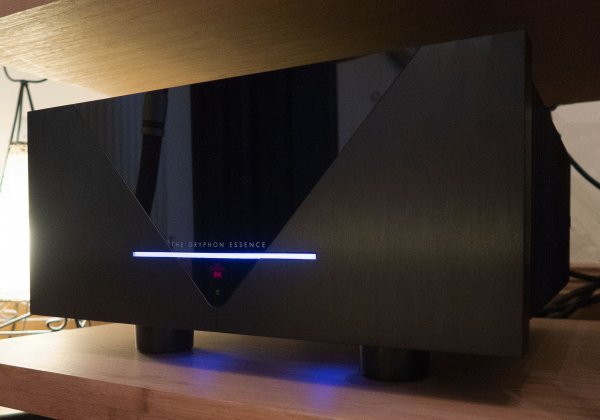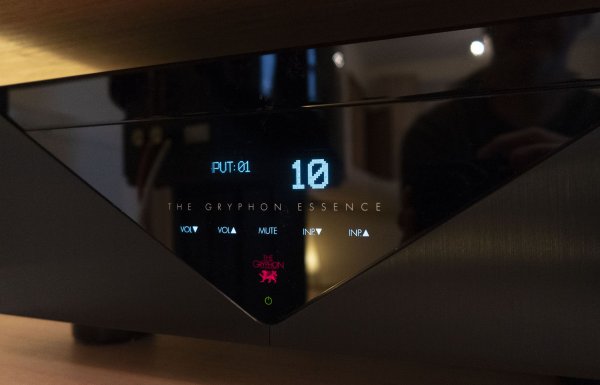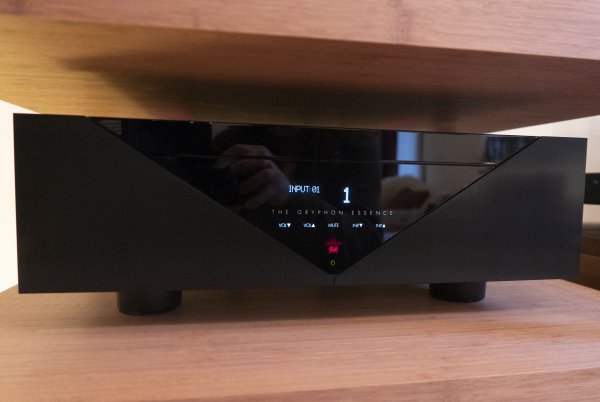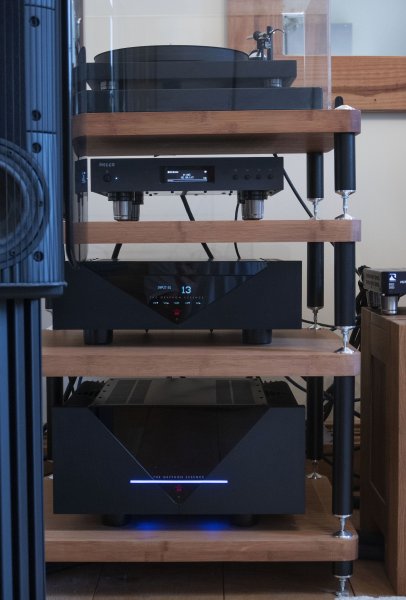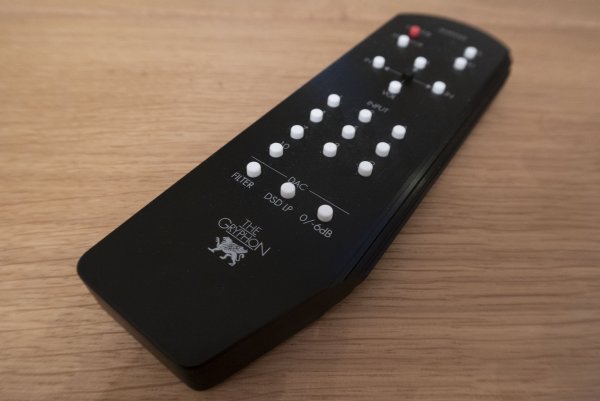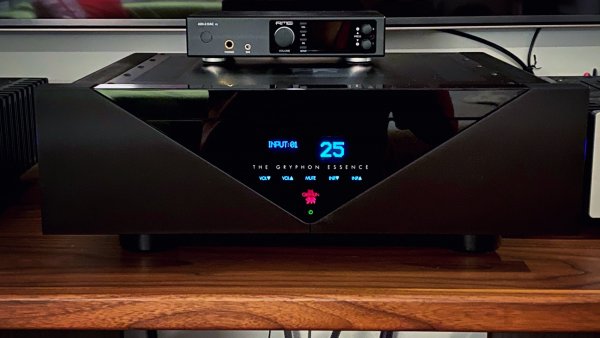After a week of listening I thought a review of my Gryphon Essence pre/stereo power amplifiers might be worthwhile. I’m a passionate music listener but this (as may become obvious) is not my day job. However, I hope the below main observations help anyone else wondering about the qualities of Gryphon’s new babies. My reference and comparison points are the Diablo 300 which I owned prior to this pair and, prior to that, Naim 252/250DR. Rest of the system is Mirus Resonessence Pro dac, Melco N1Zh server, Mojo S speakers, Gryphon Guideline Reference and VIP cabling.
Before talking about sound, a word about aesthetics. The pictures can’t do these units justice. The finish is typical Gryphon – flawless. I love the new Fleming Rasmussen design which, when it comes to the fascia layout, takes its queue from the profile of a record groove’s ‘v’ shape. It’s uber cool. The power amp sits at the bottom of my rack looking utterly menacing. Before power-up, it reminds me of the monolith from 2010 A Space Odyssey; the black, straight-edged, impenetrable block gives nothing away. It just sits there promising all kinds of awesome. Switch on and a thin blue horizontal light strip (and tiny Gryphon logo) is the only sign of life and now reminds me of Gort from The Day the Earth Stood Still. (These might be references to past icons, but this has more to do with how these up-to-the-minute, super contemporary designs resonate with my sci’ fi’ past. In reality, they wouldn’t look out of place in SpaceX). Above it, the pre’ sits with stylish poise and purpose, it’s ‘V’ pointing to the warp engine, below. It has the same perfectly flat, sleek, black acrylic and brushed steel surface. There are no controls to interfere with the futuristic finish or the digital information displayed behind it; touch screen technology sees to that; that and a handset made from a collapsed star. At first it looks a bit ordinary; until you pick it up and feel the extraordinary weight and notice the beautiful black, brushed steel finish. It sits perfectly ergonomically in the hand & possesses comprehensive functionality that is entirely intuitive.
I won't list all the technical specs, either, because you can find them on Gryphon's website, too. But the headlines are that these units are true dual mono, negative global feedback, Class A (and A/B) 2 x 50w into 8 ohms, 2 x 100w into 4 ohms... and the pre' can incorporate dac and phono modules.
Sound, then and even ‘straight out of the box’ is an OMG moment. The bass. The bass is staggering. Remember, I’m coming off the Diablo 300 which is no slouch in any department, let alone bass. It’s truly palpable and provides a rock solid, iron-fist-controlled foundation to the presentation. It’s like it is at a real gig. The impact, density, weight, textural depth and slam are in an entirely different league to those I experienced with the Diablo 300 on Dynaudio Contour 60’s – 3-ways with 2 x 9” woofers compared to the 2-way Mojo’s 2 x 5.5” mid range units. That’s a pretty clever trick. And it’s fast; no overhang, no flab. Just precise, correct. My room is 12’ x 24’ with the speakers off the short wall. Previous experience suggests this is all the bass this space can take without needing room treatments. The Contour’s went down to 28hz; Mojo is quoted, conservatively I'd say, at 37hz, but it’s very rare that I notice the lowest bass to be wanting. I certainly don’t miss the endless messing about with panels to try to counter bass boom. This is great news because, until this moment, I’d been thinking I’d need to shoehorn Pantheons into my space to gain the kind of bass and general scale I really wanted. No more.
The next most obvious feature is the sheer weight and density of the sound, spread precisely about a soundstage that has grown in every dimension and direction. Essence has freed the sound and the performers from the confines of the speakers (which have disappered) to the extent that they dance about before me with more presence and realism than I have ever experienced before. There is more three dimensionality to the sound; bass notes are more holographic; the sense of the recording space is much better defined. More detail, like background crowd shouts which I hadn’t heard before, contribute to a greater feeling of realism. In this sense, I find myself drawn into the recording space and lost in its ambience, rather than listening-in from outside. The Diablo is often described as having great authority; Essence redefines authority in this context. Bass is tight and totally controlled. Highs are extended and sweet, never etched or bright. Mids are smooth, refined, coherent; live lead vocals are just as I remember from the gigs. Instruments are better defined and separated yet the whole still binds well together and remains musical and deeply emotive. Everything is in perfect balance. No one element is jacked-up for effect. Again, every element is just ‘correct’.
On power - anyone looking at power output and worrying that it might not be enough can rest easy. The power amp holds a massive 440,000 micro farads in its capacitor bank, which is constantly available. Gryphon say it's enough to drive the most demanding loads and I believe them. It fills my space in a significantly more potent way than did even the Diablo 300 with its 300w into 8 ohms; and it maintains 100% coherence and integrity at volumes I couldn’t listen to for more than a minute.
Music notes : Nanci Griffith’s beautiful voice brought a tear because she was right there in front of me like she was in the Albert Hall 30 years ago. Gary Numan’s live electronica from the Hollywood Forever Cemetery thundered and shook its way through my lounge with the force of an Aussie 64-wheel, 3 trailer road train. The bass guitar line in Costello’s Watching the Detectives was a more textured, gripping and present foundation to that track than before; the opening, crashing drums were breathtaking, such was the weight. I’m surprised, verging on shocked, at what the Mojo S is capable of, driven by Essence. I had no idea. The piano notes of Claire de Lune timed perfectly and fell beautifully, delicately with richly textured decay; the best representation of piano I've heard. I listened to Swan Lake and heard tiers of wind and string instruments which had previously not been as distinguishable and percussion that was so fast from start to stop and had so much slam, it made be jump; then the harp with such beauty and delicacy. I could also sense the great scale of the orchestra and the space it occupied like never before. Gilmore’s guitar highs on a live Comfortably Numb were thrilling; fully extended but not shrill, textured but not dampened. Lofgren’s guitar plucks had more body and substance, putting him right in front of me, but still held onto their raw energy. If there’s texture in the recorded note, Essence reproduces it. All this extra detail retrieval and weight combines to recreate performances in a way that is utterly convincing and musical.
Essence also plays low volume exceptionally well. No recessed vocals; no dominant bass – or disappearing bass. Just the same, perfect balance. Then, at the loudest level I’m likely to want to play, there’s not a hint of any kind of degradation. Just more and more emotional connection as the soundstage fills the room. There’s no fatigue, either. I can listen for hours.
A word about Gryphon Class A and Essence. You can run the amp, fully, in either Class A or A/B. But if you connect the Green Bias cable between pre and power, the amp will automatically assign, from one of two selectable bias programmes (High or Low) Class A or A/B across three volume ranges. I’ve been listening exclusively in High Bias which, as I understand it, gives me A/B from volume 1-14 and A from volume 15 upwards. In practical terms this means I’m using quite a bit less electricity when listening at non-critical low levels and permanently drawing max power only at volume levels where I’m listening seriously. I can’t comment on sonic differences between A and A/B because I haven’t judged them, yet. But I can refer you to the comment above re: low level listening. Oh and whilst the amp gets pretty warm, it’s not as hot as I was expecting. My room was not uncomfortable during last week’s hot weather. With both doors open.
I’ll hang up my laptop there. IMO Gryphon have hit a home run with Essence. I moved from Naim because I wanted to reduce box count and because I wanted a different, perhaps more truthful, present, less frenetic kind of presentation with deeper insight. The Diablo 300 was the perfect move and is a magnificent integrated amplifier. I could have lived with it forever. But then Gryphon made their Class A more affordable and I couldn’t resist the opportunity to try it, albeit adding another box. The Essence pairing is a monumental leap in performance in every way. It’s a high-end, ultra stylish combination which I can’t recommend enough as an obvious move from the 120 or 300; or from anything else in anywhere near its price point, for that matter. Essence creates a more visceral, honest and truly lifelike representation of performers and instruments in my room than I have previously experienced. I can’t imagine what Antileon and Mephisto can do. Thankfully, I don’t need to. I’m in musical Nirvana. An excellent moment to queue up and listen to what Essence does with their MTV Unplugged in New York. I can't wait.
Before talking about sound, a word about aesthetics. The pictures can’t do these units justice. The finish is typical Gryphon – flawless. I love the new Fleming Rasmussen design which, when it comes to the fascia layout, takes its queue from the profile of a record groove’s ‘v’ shape. It’s uber cool. The power amp sits at the bottom of my rack looking utterly menacing. Before power-up, it reminds me of the monolith from 2010 A Space Odyssey; the black, straight-edged, impenetrable block gives nothing away. It just sits there promising all kinds of awesome. Switch on and a thin blue horizontal light strip (and tiny Gryphon logo) is the only sign of life and now reminds me of Gort from The Day the Earth Stood Still. (These might be references to past icons, but this has more to do with how these up-to-the-minute, super contemporary designs resonate with my sci’ fi’ past. In reality, they wouldn’t look out of place in SpaceX). Above it, the pre’ sits with stylish poise and purpose, it’s ‘V’ pointing to the warp engine, below. It has the same perfectly flat, sleek, black acrylic and brushed steel surface. There are no controls to interfere with the futuristic finish or the digital information displayed behind it; touch screen technology sees to that; that and a handset made from a collapsed star. At first it looks a bit ordinary; until you pick it up and feel the extraordinary weight and notice the beautiful black, brushed steel finish. It sits perfectly ergonomically in the hand & possesses comprehensive functionality that is entirely intuitive.
I won't list all the technical specs, either, because you can find them on Gryphon's website, too. But the headlines are that these units are true dual mono, negative global feedback, Class A (and A/B) 2 x 50w into 8 ohms, 2 x 100w into 4 ohms... and the pre' can incorporate dac and phono modules.
Sound, then and even ‘straight out of the box’ is an OMG moment. The bass. The bass is staggering. Remember, I’m coming off the Diablo 300 which is no slouch in any department, let alone bass. It’s truly palpable and provides a rock solid, iron-fist-controlled foundation to the presentation. It’s like it is at a real gig. The impact, density, weight, textural depth and slam are in an entirely different league to those I experienced with the Diablo 300 on Dynaudio Contour 60’s – 3-ways with 2 x 9” woofers compared to the 2-way Mojo’s 2 x 5.5” mid range units. That’s a pretty clever trick. And it’s fast; no overhang, no flab. Just precise, correct. My room is 12’ x 24’ with the speakers off the short wall. Previous experience suggests this is all the bass this space can take without needing room treatments. The Contour’s went down to 28hz; Mojo is quoted, conservatively I'd say, at 37hz, but it’s very rare that I notice the lowest bass to be wanting. I certainly don’t miss the endless messing about with panels to try to counter bass boom. This is great news because, until this moment, I’d been thinking I’d need to shoehorn Pantheons into my space to gain the kind of bass and general scale I really wanted. No more.
The next most obvious feature is the sheer weight and density of the sound, spread precisely about a soundstage that has grown in every dimension and direction. Essence has freed the sound and the performers from the confines of the speakers (which have disappered) to the extent that they dance about before me with more presence and realism than I have ever experienced before. There is more three dimensionality to the sound; bass notes are more holographic; the sense of the recording space is much better defined. More detail, like background crowd shouts which I hadn’t heard before, contribute to a greater feeling of realism. In this sense, I find myself drawn into the recording space and lost in its ambience, rather than listening-in from outside. The Diablo is often described as having great authority; Essence redefines authority in this context. Bass is tight and totally controlled. Highs are extended and sweet, never etched or bright. Mids are smooth, refined, coherent; live lead vocals are just as I remember from the gigs. Instruments are better defined and separated yet the whole still binds well together and remains musical and deeply emotive. Everything is in perfect balance. No one element is jacked-up for effect. Again, every element is just ‘correct’.
On power - anyone looking at power output and worrying that it might not be enough can rest easy. The power amp holds a massive 440,000 micro farads in its capacitor bank, which is constantly available. Gryphon say it's enough to drive the most demanding loads and I believe them. It fills my space in a significantly more potent way than did even the Diablo 300 with its 300w into 8 ohms; and it maintains 100% coherence and integrity at volumes I couldn’t listen to for more than a minute.
Music notes : Nanci Griffith’s beautiful voice brought a tear because she was right there in front of me like she was in the Albert Hall 30 years ago. Gary Numan’s live electronica from the Hollywood Forever Cemetery thundered and shook its way through my lounge with the force of an Aussie 64-wheel, 3 trailer road train. The bass guitar line in Costello’s Watching the Detectives was a more textured, gripping and present foundation to that track than before; the opening, crashing drums were breathtaking, such was the weight. I’m surprised, verging on shocked, at what the Mojo S is capable of, driven by Essence. I had no idea. The piano notes of Claire de Lune timed perfectly and fell beautifully, delicately with richly textured decay; the best representation of piano I've heard. I listened to Swan Lake and heard tiers of wind and string instruments which had previously not been as distinguishable and percussion that was so fast from start to stop and had so much slam, it made be jump; then the harp with such beauty and delicacy. I could also sense the great scale of the orchestra and the space it occupied like never before. Gilmore’s guitar highs on a live Comfortably Numb were thrilling; fully extended but not shrill, textured but not dampened. Lofgren’s guitar plucks had more body and substance, putting him right in front of me, but still held onto their raw energy. If there’s texture in the recorded note, Essence reproduces it. All this extra detail retrieval and weight combines to recreate performances in a way that is utterly convincing and musical.
Essence also plays low volume exceptionally well. No recessed vocals; no dominant bass – or disappearing bass. Just the same, perfect balance. Then, at the loudest level I’m likely to want to play, there’s not a hint of any kind of degradation. Just more and more emotional connection as the soundstage fills the room. There’s no fatigue, either. I can listen for hours.
A word about Gryphon Class A and Essence. You can run the amp, fully, in either Class A or A/B. But if you connect the Green Bias cable between pre and power, the amp will automatically assign, from one of two selectable bias programmes (High or Low) Class A or A/B across three volume ranges. I’ve been listening exclusively in High Bias which, as I understand it, gives me A/B from volume 1-14 and A from volume 15 upwards. In practical terms this means I’m using quite a bit less electricity when listening at non-critical low levels and permanently drawing max power only at volume levels where I’m listening seriously. I can’t comment on sonic differences between A and A/B because I haven’t judged them, yet. But I can refer you to the comment above re: low level listening. Oh and whilst the amp gets pretty warm, it’s not as hot as I was expecting. My room was not uncomfortable during last week’s hot weather. With both doors open.
I’ll hang up my laptop there. IMO Gryphon have hit a home run with Essence. I moved from Naim because I wanted to reduce box count and because I wanted a different, perhaps more truthful, present, less frenetic kind of presentation with deeper insight. The Diablo 300 was the perfect move and is a magnificent integrated amplifier. I could have lived with it forever. But then Gryphon made their Class A more affordable and I couldn’t resist the opportunity to try it, albeit adding another box. The Essence pairing is a monumental leap in performance in every way. It’s a high-end, ultra stylish combination which I can’t recommend enough as an obvious move from the 120 or 300; or from anything else in anywhere near its price point, for that matter. Essence creates a more visceral, honest and truly lifelike representation of performers and instruments in my room than I have previously experienced. I can’t imagine what Antileon and Mephisto can do. Thankfully, I don’t need to. I’m in musical Nirvana. An excellent moment to queue up and listen to what Essence does with their MTV Unplugged in New York. I can't wait.


